混合办公时代下的多维度健康设计
2022-04-22LWKPARTNERS董事张家豪
文/图:LWK+PARTNERS 董事 张家豪
简介
现代社会的工作模式从未像今天如此多元化。越来越多跨国企业正在日常运营中采用“混合模式”,而这种模式正逐渐影响企业对办公空间的要求。
正当共享空间成功把不同专业领域、需求和工作习惯的人凝聚到同一地方,大型企业的领域也日趋多元化,例如工程公司会招聘政策专家,学术研究可以跨部门进行,零售品牌也陆续扩大其产品和服务的种类以提高市场覆盖。
这意味着一些拥有截然不同背景、知识技能以及需求的人正在同一个空间中工作并相互协作。而随着人们越来越醒觉到日常环境的条件对整体长远健康质量的重要性,而雇主亦了解到员工健康与业务表现之间的密切关系,“健康”理念在建筑设计就大行其道。对雇主及建筑运营方来说,一个首要的目标就是确保工作环境健康并能激发思维,让员工高效工作,同时为社区带来增值效益。
具灵活性的多功能社区
人们的健康是全面和多维度的。人们花大约三分之一的时间在工作场所,日常除了业务需求外,还有各种个人需求。
随着工作和生活模式的边界逐渐模糊,未来的办公综合体将演变成高效、流动的社区,使用者可以便捷地享用各种空间功能,包括灵活的工作站、休息空间、展览场地、艺术和表演空间、医疗保健、零售、餐饮、体育设施及绿化空间等。
这种混合用途的趋势除了提高商业效率外,亦提供一种愉悦的共享文化,同时鼓励各种社交和文化活动,营造具活力的公共体验。工作空间正蜕变成一种多功能社区,鼓励人们到来聚会、逗留、与他人交流协作或进行个人创作。
然而,单纯地“多用途”是不足够的。2019 冠状病毒病疫情的经验告诉我们,为确保可持续的业务运营,灵活性绝对是另一项同样重要(甚至更加重要)的工作场所特质。
弹性的工作模式正成为留住人才的关键要素,尤其是对新生代来说。“EY 2021 工作重塑雇员调查”就对来自 16 个国家、23 个行业中超过 16,000 名员工采集意见。如果在工作地点和时间上没有某种形式的灵活性,54% 的员工会考虑在疫情缓和后离开其工作岗位,而千禧世代辞职的可能性是婴儿潮那一代人的两倍(EY 2021)。
类似的现象也反映在全球管理咨询公司麦肯锡的一项调查,该调查访问了约 5,000 名员工,发现近四分之三的员工表示希望在疫情后仍可以每周在家工作两天或以上(De Smet et.al 2021)。
建构一个配套完善的多样化办公空间有助企业适应后疫情时代及留住顶尖人才。在混合办公模式下,任何时候都可能有部分员工正在远端工作,而协调员工在办公室内外的合作对雇主及设计师来说都是一项挑战。空间的设计必须迎合不同人的工作节奏、习惯和模式 — 包括单独工作、面对面会议、虚拟会议、头脑风暴、跨领域合作、知识共享、论坛讨论等。为了提升用家体验,建筑师的任务就是要妥善串连各种空间元素,并无缝连接至步行动线系统、错落空间、多层绿化和公共区域。
以 LWK+PARTNERS 项目中国杭州镓谷科学园为例(见图 1 和图 2)。项目位于云计算产业园,我们团队采用了园林办公设计,在为未来的使用者提供源源灵感、互相连接的共享空间和社交机会,增进沟通与合作的体验。项目将建有实验室、共享办公室及会议室、体育设施、展览空间、餐厅和商店,打造多功能的建筑环境。公共空间渗透多个楼层,包括位于三层的环型空中平台,连接餐厅、空中花园及其他康乐设施(见图 3)。
较高的建筑在面向中央庭园的部分采用了退台设计,为电梯大堂、茶水间等公共空间引入自然风和阳光。项目透过模糊办公、健康、生活和庭园等不同功能空间之间的界线,有望成为未来工作间的主要发展模式,促进高科技企业对工作与生活平衡的实践。
加倍重视健康质量
对员工健康的重视有利企业吸引人才,疫情发生之后该趋势也更为明显,而企业也更愿意在这方面投资。早在疫情爆发前,全球咨询公司 Willis Towers Watson 就指出,全球 66% 企业和亚太地区 60% 企业都把关怀员工健康视为四大优先员工福利之一(Willis Towers Watson 2019)。全球健康研究机构 Global Wellness Institute 的最新数据也显示,亚太地区雇主在工作场所的健康计划/服务支出由 2015 年到 2017 年间,每年增长 5.1%,达到 93 亿美元(GWI 2018)。
研究显示,灵活的办公设计能有效减少员工坐着的时间(Wallmann-Sperlich et al.2019)。一个步行友善的环境以及可达性高、设于不同楼层的大小绿化及露天空间,都能鼓励人们四周走动和伸展,越来越多办公综合体提供各种运动及康乐设施,鼓励人们将运动习惯融入到日常工作之中(见图 4)。
一个健康的环境应该令人感到舒适并愿意长时间逗留。在办公环境中,人们经常长时间聚精会神埋头工作,尤其是在提交日期临近或工作量增加的时候。提供舒展身心的空间能刺激大脑活动,同时提高工作效率,更可在工作空间范围加入楼梯设计,促进垂直空间流动,同时营造视觉焦点;使用可调节高度的办公桌让人们可以在工作时站起来,亦方便进行讨论。
工作环境中的灯光亦会影响职业健康,但有时会被雇主忽视。合适的光线确实有助提升工作表现(CBRE 2017)。结合大窗户、天窗、活动窗和被动遮阳装置等不同装置都能增加自然采光,并有效地减少室内工作者所受的眩光影响(见图 5),而最理想就是让使用者根据不同的天气和工作性质调整光线强度。
维持适合的室内温度和良好通风对员工的健康同样重要,可透过打通室内空间与露天平台,或者交错的楼层设计,将充足的新鲜空气引入办公室,而贯穿室内主要办公空间的大型楼梯则可加强楼层间的空气流动,安装冷却天花板系统还可以确保冷气均匀地分布。
满足心理、灵性和社交需要
世界卫生组织估计,抑郁和焦虑症每年为全球经济造成一万亿美元的损失(WHO 2019),亦有其他研究指出,员工满意度对工作表现有正面影响(Bellet,De Neve&Ward 2019)。因此,工作场所的设计必须兼顾员工的心灵需要,才能让他们保持头脑清醒,应对未来各种工作挑战。
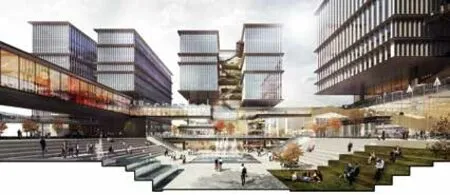
图1.中国杭州镓谷科学园设计成一个灵活的工作场所,提供各种共享设施和多层次的开放空间,营造更多社交机会。Figure 1.Gallium Valley Science Park in Hangzhou,China is designed as a flexible workplace with a variety of shared amenities,surrounded by a multitude of shared open spaces for greater social opportunities.
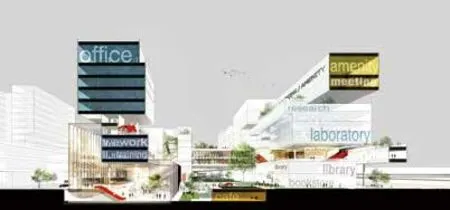
图2.中国杭州镓谷科学园的设计以错落空间布局多功能元素,吸引人们使用。Figure 2.The program engages users with multipurpose components designed in interlocking spaces.
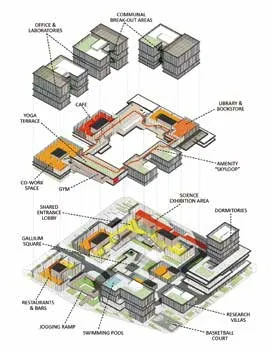
图3.中国杭州镓谷科学园的环型空中平台将办公空间与餐厅、空中花园及其他康乐设施串连起来。Figure 3.A communal “sky-loop” platform connects office spaces with amenities like eateries,roof gardens,and other recreational facilities.
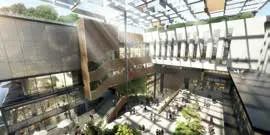
图4.中国镓谷科学园的园林办公设计透过打通不同空间,鼓励人们多走动。Figure 4.The Gallium Valley Science Park features an office-park environment with interconnected spaces to encour-age people to move around.

图5.沿建筑立面减去体量有助采光及通风。Figure 5.Recesses cut out along building elevations allow sunlight and ventilation to enter the buildings.
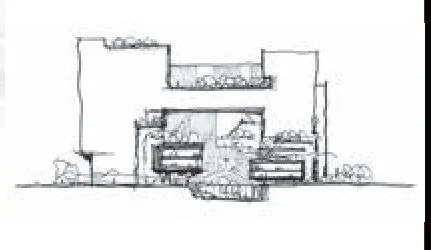
图6.通过体量切割制造开放及露天空间,创造良好的通风条件。Figure 6.Open-air spaces cut into the building elevation allow for a well-ventilated experience.
促进团队自由沟通是人事管理的长期目标。一项研究显示,61% 的美国员工认为心理健康会影响他们的工作效率(Mind Share Partners 2019),但另一项调查同时发现,全球只有 30% 的员工愿意与上司谈论他们的心理健康(Segel 2021)。
设计不同隐私度的空间可鼓励员工参与不同类型的活动。虽然开放式布局的确能提供宽敞和高透明度的感觉,但员工亦同时需要一些较隐密的位置,可以不受干扰地向管理层表达意见。另外,参与人数较多的论坛、培训和团建活动可以利用露天剧场和会议室(见图 6)。
体验自然环境绝对是培养精神健康的一部分。研究指出,提高人们在工作场所与绿植的物理及视觉接触,能有助减压(Toyoda et al 2020)。对种植和绿化的重视亦因此成为 21 世纪建筑的主流趋势,为使用者提供喘息空间。
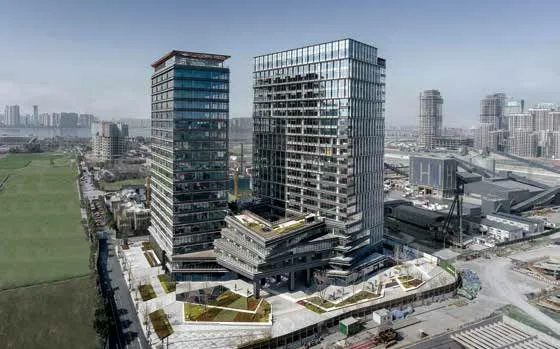
图7.中国杭州奥体万科中心一改办公建筑的既有做法,破格以中央庭园取代中心入口位置 。Figure 7.Aoti Vanke Centre in Hangzhou disrupts the established norm in office architecture by featuring a courtyard garden in the central core.
在 LWK+PARTNERS 我们将以上趋势进一步延伸,并充分体现在中国杭州奥体万科中心的设计中。该创新办公枢纽项目以园林为主要设计概念(见图 7 和图 8),我们团队一改传统办公建筑将大堂置于心脏位置的做法,破格以中央庭园取代中心入口位置,大堂向两边后退以腾出城市绿化空间。裙楼从地面升高,更对每层进行不同程度的旋转,重新演绎了“裙楼+塔楼”建筑,做出各式各样的步行空间。
奥体万科中心除了作为办公及社交枢纽外,也是一座充满独特美感的建筑。当人们从庭园抬头仰望时,会看见建筑体量婉转交错,予人一种难忘而充满跳跃活力的感官冲击。项目空间提供翠绿和宁静的环境,远离喧嚣和繁忙的城市,营造出冥想的氛围,令人身心恬静。
办公室应是个可以互相交流意见及建立人际网络的地方。宽阔的走廊通道、开放式露台和宽敞的休息空间都有助促进随意的交流互动,而员工之间的支持和人与人之间的接触可以缓解压力。疫情期间持续的社交隔离使心理健康成为大众焦点,突出我们与其他人互动并共享同一空间的需要。
与此同时,独处亦很重要。小休时段的自我反省或私人专属时间可以带来启发、疗愈作用,甚至提升生产力。随着人们对自身健康的意识兴起及对觉知生活的追求大增,未来的办公空间应提供宁静的空间,尤其是一些需要员工大量发挥创造力或洞察力的公司。
艺术促进偶然的生活发现,刺激人们不同的感官,并赋予工作空间独特的个性;它能启发更丰富的氛围、情感及鼓励人们在空间走动时展开对话。这些不一定需要大量艺术品,而是可以通过建筑的形态、深度和色彩创造出节奏和动感。
生态友善设计与社区健康
办公大楼曾经只被视为都市繁荣发达的物理象征,但现代办公大楼在设计时更着重功能和美学上与周围环境相协调,将健康的考虑扩展到建筑使用者以外,重新联系人与自然,同时减少对城市野生动植物的干扰,为整体社区带来益处。
生态友善设计是同时促进人和环境健康的方案,逐渐成为设计办公场所的大趋势。创造生态友善空间的方法包括引入水景、非反光表面、生命墙,避免使用向外照射的强灯以及优先使用天然或回收物料等。Kellert 和Calabrese(2015)提出打造生态友善体验的三组元素的设计框架(见图 9)。
通风走廊、植物墙和穿孔或百叶立面等可渗透元素促进风和阳光穿过建筑物,更可减低高密度环境中的街谷效应。近年的商业发展也更着重模糊室外和室内的边界,包括利用空中花园、露天中庭、室内庭园,或让树木直接穿透天窗等等(见图 10)。
与自然环境融合的方式十分多元化,包括采用自然元素、大地色调、雨水花园,以及木材、陶瓦、竹和再生钢材等环保材料。
甚至,关于零能耗建筑的讨论也越来越多,这种新兴的建筑自身就能够产生电力,同时尽量节省能源消耗,减低对外部电力的需求。
项目的动线规划应考虑整个社区的人流,营造具包容性的社区。办公楼不应只限于员工使用,而是演变成元素丰富的混合功能空间,把公共空间、空中花园和活动场地开放给附近的居民,鼓励公众一同享用,同时融合附近街道令整个社区带来视觉上的和谐。
奥体万科中心通透的社交空间就是一个例子(见图11),架空层接通地块南北两端提供一条通行的捷径,并与附近街道的人流融合,而庭院周围的绿化带和零售设施亦鼓励大众享用。
再看 LWK+PARTNERS 的综合体项目中国南京五星广场。我们团队在设计上超越五天工作周的界限,为员工、在当地生活或工作的居民以及访客提供共享社区空间(见图 12 和图 13),设有两座办公室总部、员工公寓及以文化和家庭为导向的商业街。
采用物联网(IoT)的响应式工作空间
随着弹性的混合办公模式兴起,每个人上班时间有所不同,办公楼的使用率将更为分散。数字化的需求增加也同时使未来办公空间的能源需求大增。在保护环境的同时优化用户体验是建筑师必须面对的挑战,比如善用结合建筑资讯模型(BIM)的智能建筑方案。
清华大学、万科及中国微软于 2021 年 5 月联合发布的《智慧办公建筑评价标准》由中国城市科学研究会认可及运营(Microsoft 2021)。报告提出 61 项标准,用于评估办公环境是否符合人体工学、高效和创新,为中国设计和运营优质智能办公场所制定准则,评估一个场所在提高健康、安全、能源效益、减碳、生产力、管理效率、用户满意度等各方面的表现。
上述报告由官产学三方共同合作,突显智能办公在中国的发展趋势,吸引各大公私营机构参与。
智能建筑的成功取决于不同 IoT 传感器和大楼设备的相互联系和响应,使大楼成为独立运作的生态系统。
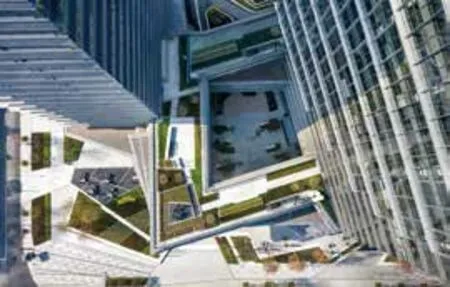
图8.中国杭州奥体万科中心提供通透的社交空间连接附近的街道。Figure 8.The central courtyard of Aoti Vanke Centre is a permeable social space that integrates with the surrounding streetscape.
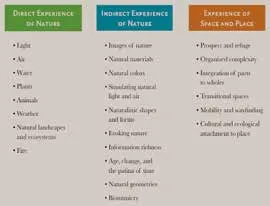
图9.生态友善体验的元素(Kellert and Calabrese 2015)。Figure 9.Elements of a biophilic experience.Source:Kellert and Calabrese 2015.

图10.中国杭州镓谷科学园的公共露台让新鲜空气和阳光进入核心空间。Figure 10.Communal terraces at the Gallium Valley Science Park let fresh air and sunlight into core spaces.
IoT 传感器实时收集环境数据和用户使用空间的模式,让运营商分析以改善未来运营及使用者体验。传感器涵盖的范围由温度、空气质素和光线到用水、空间占用状况、人们动态等,还可以侦测安全问题、设备位置异常及需要检查或维修的地方。
收集到的数据可与大楼管理系统结合,包括电灯开关、空调、遮阳设备等,例如没有人的时候自动关掉不必要的电灯、来自天文台的天气预报可以与过去的空间占用数据相结合,预测最佳能源使用水平及设备配置。
有效的响应式环境迎合不同使用者的需求和习惯,带来流畅多样的使用者体验(见图 14),更提高安全、健康、员工满意度、资源效益及建筑物维护的质素。
长远来看,这些能够“独立运作”的智能建筑有助推动社会迈向净零碳未来。目前,建筑行业占全球能源相关碳排放量达 40%(WorldGBC 2020)。
国际能源署(IEA)预计,在建筑物采用智能控制及装置连接有助于 2040 年前节省 230 艾焦耳,从而降低10% 全球建筑能耗,同时为大楼使用者提供更佳的热舒适度(UNEP &IEA 2017)。
为降低全球碳排放,全球各地的建筑师都在积极发展具能源效益的零能耗建筑。零能耗建筑能够就地产生足够的洁净能源自给自足,达至零能耗。若加上政府的支持、数字化基建和城市规划,智能建筑将改变我们的生活方式,促进建构真正智慧城市。
重新构想办公空间
远程办公并不能适用于所有工种,因此实体办公空间在未来一段时间将仍然是关键的工作场所,尤其是对知识型工作者而言。与此同时,疫情加速了全球工作模式转变,人们对健康的重视程度亦大增,也影响到人们心目中对理想办公场所的想象。
灵活性对理想的办公场所无疑是决定性的关键因素。雇主了解到灵活的工作模式是留住及吸引优质人才的优点,也能提高运营弹性,尤其是在全球流动性受到限制的时期。因此,未来办公空间的特性和设计必须让人们能够按照自身需要,选择最适合自己的工作模式。
为了让使用者尽量发挥自己的工作能力和创造力,健康应被视为全面及多维度的概念。未来的办公场所设计需要不同专业领域相互合作,尤其是当 BIM 和 IoT 技术的结合对创造舒适、高效的使用者环境变得越来越重要。人们对工作与生活平衡的追求越来越重视,进一步模糊工作场所与“第三空间”的边界。为了优化使用者体验,建筑师的设计目标将远远超越建筑功能,追求更多实践心灵健康及激发人与人互动的方向。
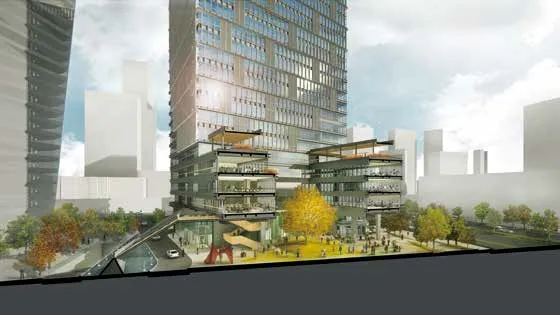
图11.中国杭州奥体万科中心的裙楼从地面升高,架空层接通地块南北两端,提供一条通行的人行捷径。Figure 11.The podium of Aoti Vanke Centre is elevated,connecting two ends of the overall site and providing a shortcut for people to pass through.
Introduction
Never have the modes of work been so diverse in contemporary history.A growing number of multinational employers are transitioning to"hybrid mode" in their daily operations,which is already having an influence on the kinds of workspaces they build for employees.
While coworking spaces are known for their ability to bring individuals of different professions,needs,and work routines together in one place,larger corporations are also becoming increasingly multidisciplinary.Engineering firms are recruiting policy experts,academic research is done across departments,and retail brands are diversifying their product and service offerings to boost market coverage.
All this means that people with very different backgrounds,knowledge and skills,and who have varying needs of their own,are working alongside and collaborating with each other in the same space.At the same time,"well-being"is becoming a strong consideration in building design,as people are now hyper-aware of how the conditions of their daily surroundings affect longterm wellness.Meanwhile,employers increasingly recognize that staff well-being is critically linked to business performance and resilience.Ensuring that people work productively in a healthy and inspiring environment,while bringing added value to the community,is now a high priority for both employers and building operators.
Multifunctional,Flexible Neighborhoods
Human well-being is holistic and multidimensional.People spend about a third of their time in their workplaces,and individuals have a range of needs to fulfill throughout the day,in addition to business requirements.
As the boundary between work and lifestyle continues to break down,future office complexes will evolve into efficient,fluid communities where a wide range of spatial functions are within convenient reach of users.These include,but are not limited to flexible workstations,breakout spaces,exhibition venues,arts and performance spaces,healthcare,retail,food and beverage (F&B),sports facilities,greenery,etc.
This mixed-use trend promises not just commercial efficiency,but a joyous and shared culture that encourages a variety of simultaneous social and cultural happenings,generating dynamic energy and a communal experience.The workspace is essentially becoming a multifunction neighborhood,where people gather,dwell,and create with one another,or in their own productive ways.
But simple diversity is not enough.The COVID-19 pandemic has shown that,to ensure sustainable business operations,flexibility is equally– if not more– critical as a workplace quality.
The ability to provide flexible work options is also rising as an important attribute for talent retention,especially among the new generation.According to the EY 2021 Work Reimagined Employee Survey,which surveyed more than 16,000 employees from 16 countries across 23 industries,54 percent of employees would consider leaving their jobs after the pandemic if they are not afforded some form of flexibility in where and when they work,and millennials are twice as likely to quit as baby boomers(EY 2021).
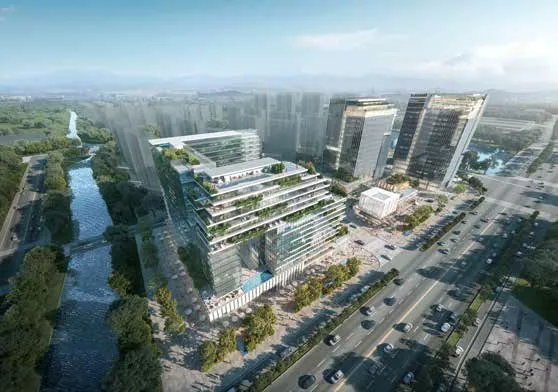
图12.中国南京五星广场提供两个办公室总部、计划用于员工住宿的公寓和以文化及家庭为导向的商业街。Figure 12.The FSH Plaza,a mixed-use development in Nanjing,includes two headquarters offices,apartments planned for staff accommodation,and a retail street with a cultural and family-oriented retail mix.
This is echoed by a survey by global management consultancy McKinsey,which reported that nearly three-quarters of 5,000 employees surveyed globally said they would like to work from home for two or more days per week after the pandemic(De Smet et al.2021).
A sensible curation of amenity-rich mixed-use spaces is a valuable asset that helps companies adapt to a post-pandemic society and retain top talent.Under hybrid working,there will always be part of the workforce working remotely.Facilitating collaboration between those in and out of the office is a challenge,not only for employers,but also designers.Spaces must be designed to accommodate different workstyles,routines and modes of work– private work,face-to-face meetings,virtual conferencing,brainstorming,cross-disciplinary collaborations,knowledge sharing,forum discussions,etc.To elevate the user experience,it remains a task for the architect to link these components seamlessly with walkable circulation systems,interlocking volumes,multilayered greenery,and common areas.
Take Gallium Valley Science Park,our project at LWK+PARTNERS,for example.For this office park located in Cloud Valley in Hangzhou,China,our intention is to surround future users with lots of inspiration,interconnected shared spaces,and social opportunities (see figures 1 and 2).It also aims to improve and enrich the experience of communication and collaboration.
The project consists of laboratories,coworking and meeting spaces,sports facilities,exhibition venues,restaurants and retail outlets,to make up a comprehensive program.A communal “sky-loop”platform on Level 3 connects office spaces with amenities like eateries,roof gardens,and other recreational facilities (see Figure 3).
Taller blocks feature major recesses on building envelopes facing the central courtyard,creating communal terraces to let in fresh air and sunlight into core spaces like lift lobbies and pantries.The project seeks to blur the lines between work,wellness,lifestyle,and the park,potentially becoming a signature type of workspace that fosters a work-life balance in the science-tech industry.
Expanding Focus on Bodily Health
Commitment to staff well-being helps attract talent—a trend amplified by the pandemic—and employers are investing more in it.Even before the pandemic,global advisory Willis Towers Watson found that supporting staff well-being is one of the top four staff benefits priorities for 66 percent of companies globally,and 60 percent in Asia-Pacific (Willis Towers Watson 2019).The latest data from the Global Wellness Institute also reveals that Asia-Pacific employer expenditures on workplace wellness programs/services grew 5.1 percent annually from 2015 to 2017,to US$9.3 billion (GWI 2018).
Research has shown that active office designs have a positive effect on reducing employees’ sitting time (Wallmann-Sperlich et al.2019).A walkable environment with easy access to greenery and open spaces at different levels and scales encourages people to move around and exercise,while a growing number of office complexes nowadays offer a range of sports and recreational facilities for people to merge their workout routine into their work schedules (see Figure 4).
Addressing well-being is also about creating a space where people feel comfortable to stay for a long time.In an office environment,people can easily be drawn to hours of intense,focused working when assignment deadlines approach,or when workloads grow.Spaces that promote movement throughout the day can make a difference,as physical exercise can stimulate brain activity and speed up task completion.Inserting a feature staircase can be a way to encourage vertical movement,while providing a point of visual attraction.Using desks with adjustable heights allows people to stand up while working,and it also provides an easier setting for group discussion.
Lighting is an aspect in occupational well-being sometimes overlooked by employers.But the right lighting does enhance people’s performance at work (CBRE 2017).A combination of large openings,skylights,operable windows and passive shading devices all help optimize natural lighting and minimize glare for indoor workers (see Figure 5).Ideally,users can adjust the intensity of lighting,according to the weather and the nature of their task.
Maintaining the right indoor temperature and good ventilation are equally important for safeguarding the well-being of workplace users.Interiors that open out into outdoor terraces,and floor plates cutting into each other can be good ways to draw ample fresh air into the office,while large,visible indoor staircases piercing through the main office space allow air to move from one floor to another.Chilled ceiling systems can also be installed to ensure even distribution of cool air.
Nourishing the Mind,Soul,and Social Self
The World Health Organization (WHO) estimates that depression and anxiety cost the global economy US$1 trillion per year in lost productivity(WHO 2019),while other studies show that employee satisfaction has a positive effect on performance (Bellet,De Neve &Ward 2019).Workplaces,therefore,should be thoughtfully designed to nourish the mind and soul for workers to keep their brains fresh for the challenges ahead.Promoting open communications within the team is a long-standing objective in people management.A study reveals that 61 percent of employees in the United States think their productivity at work is affected by their mental health (Mind Share Partners 2019) but a separate survey found only 30 percent of global employees feeling comfortable talking to their manager about their mental health (Segel 2021).
Designing a range of spaces that vary in privacy levels ensures that different kinds of staff engagement activities can take place.While open-plan layouts may convey a sense of spaciousness and transparency,employees also need more secluded booths to voice out their concerns to management in private,undisturbed conversations.Forums,training,and team-building sessions with a larger number of participants can make use of open-air theatres and meeting rooms(see Figure 6).
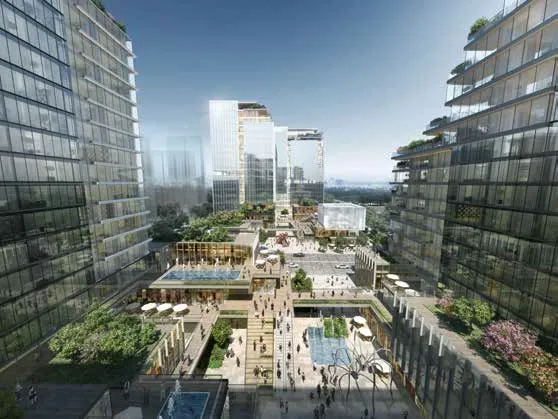
图13.中国南京五星广场综合体超越五天工作周的界限,提供共享社区空间。Figure 13.The FSH Plaza,a mixed-use development in Nanjing,goes beyond the considerations of the five-day working week to create an inviting space for community enjoyment.
Experience with nature is definitely part of mental nourishment.Research has shown that different interventions to improve physical and visual access to workplace greenery help reduce human stress levels (Toyoda et al 2020).Therefore,incorporating plantings and greenery has become a mainstream option for 21st-century architecture to provide relaxing breathing spaces for users.
Our team at LWK+PARTNERS took this emphasis on greenery further for Aoti Vanke Centre in Hangzhou,China,with a design that uses the garden as a central driving concept (see figures 7 and 8).As an innovative working hub,the project disrupts the established norm in office architecture that dictates the prime central spot should be occupied by tower lobbies.
Instead,the lobbies take a step back from the forefront,allowing the central courtyard to double as an entry point at the heart of the site,opening up more space to integrate and engage with the urban fabric.Above the courtyard is an elevated podium,each successive level of which rotates by a different degree,reinterpreting the podium-tower typology to create myriad walking spaces for people's enjoyment.
The project program extends beyond being solely a gathering and social hub for the office workers,but also offers spaces with a distinctive architectural quality.This affords an iconic,dynamic,and sensational moment as one looks up the courtyard,seeing the twisting and shifting of the architecture language of the podium projecting onto the tower.Together with the lush and serene environment secluded away from the noise and the busy city environment,the space also offers a meditative ambiance,giving peace of mind to occupants.
The office should be a place for exchanging ideas and building networks.Casual interactions should be fostered through wide corridors,open terraces,and generous lounge spaces,as peer support and encounters with people help relieve stress.Periods of pandemic-induced isolation and social distancing have highlighted our need to interact and physically share a space with other human beings.
At the same time,the importance of solitude should be recognized.A moment of self-reflection or "me-time" during breaks can be inspirational,therapeutic,and productive.With the rise of"self-care" and growing receptiveness towards a mindful lifestyle,the future workspace should include pockets of quiet spaces,especially in companies where creativity or insight is part of employee output.
Art facilitates serendipity,stimulates different human senses and gives the workspace a unique identity.It inspires a richer ambience,emotions,and encourages dialogue between people moving in the space.This does not necessarily require a large number of artworks,but creating rhythm and movement through architectural forms,depth,and hues can be a promising approach.
Biophilic Design and Communal Well-Being
Office buildings were once developed purely as landmarks of prosperity and development.Today,a more considerate approach would be to harmonize the building with its surrounding landscapes functionally and aesthetically,extending considerations for well-being beyond building users to produce holistic benefits for the community,help people reconnect with nature and minimize disruptions to urban wildlife.Biophilic design presents a solution that promotes human and environmental well-being,and it is growing as a workplace design trend.Integration of water features,use of non-reflective surfaces,living walls,avoidance of outward-facing bright lights,and prioritizing natural or recycled materials are some of the approaches to creating an ecofriendly development.Kellert and Calabrese (2015)set out a design framework showing three groups of elements contributing to a biophilic experience(see Figure 9).
Introducing permeable elements like wind corridors,plant walls,and perforated/louvered façades encourages wind and sunlight to pass through the building.Especially in high-density contexts,this mitigates the "street canyon" effect.Blurring the boundary between outdoors and indoors,more recent commercial developments have come to embrace a new style of building forms,featuring hanging gardens,open-air atria,winter gardens,trees growing through floor penetrations,and more (see Figure 10).
Integration with the physical surroundings can also be expressed in the use of natural forms,earth-tone palettes,rain gardens,and eco-friendly materials like timber,terra cotta,bamboo,and recycled steel.
Taking a step further,there has also been increasing discussion about zero-energy buildings,an emerging typology that produces its own power,with minimal consumption of externally sourced energy.
To create a socially inclusive landscape,the overall community should be included in circulation planning.Rather than restricting the office building to workers,nearby residents can be invited to use and participate in the complex,especially as the workplace evolves into diverse mixed-use programs.Public realms,skygardens,and event venues can be designed for public enjoyment,while integration with the surrounding streetscape brings visual harmony to the neighborhood at large.
As an example,the central courtyard at Aoti Vanke Centre is a very permeable social space (see Figure 11).Connecting two ends of the overall site,it provides a shortcut for people to pass through and integrates with the pedestrian flow in the surrounding streetscape.Members of the public are also encouraged to enter and enjoy the varietyof green spaces and retail facilities located around the courtyard.
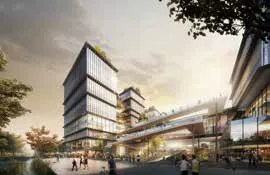
图14.有效的响应式环境为不同需求和习惯的使用者带来流畅多样的使用者体验。图为中国杭州镓谷科学园。Figure 14.An effective,responsive environment brings about a well-curated user experience tailored to the needs and habits of different occupants.Shown here:a rendering of Gallium Valley Science Park in Hangzhou.
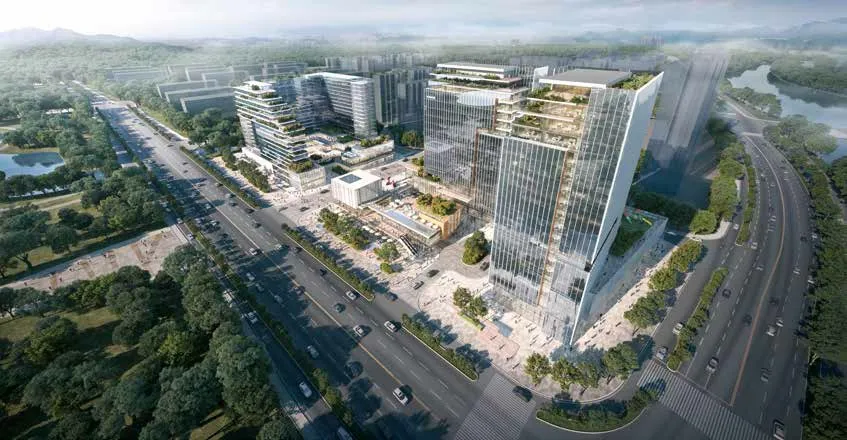
中国南京五星广场
For another project,the FSH Plaza,a mixeduse development in Nanjing,our team at LWK +PARTNERS goes beyond the considerations of the five-day working week to create an inviting space for community enjoyment (see figures 12 and 13).The project offers two headquarters office blocks,apartments for staff accommodation,and a street with a cultural and family-oriented retail mix,accommodating the family life of employees,people who live or work in the area,and those who may just be visiting.
Responsive Workspaces via the Internet of Things (IoT)
As flexible,hybrid work kicks in,occupancy of the office building will be distributed around the clock as people come to work at different times of the day.With demand for digitalization rising at the same time,energy demand will increase in our future workspaces.Optimizing user experience while pursuing environmentally-sound strategies is a challenge every office architect today must address,to which smart solutions that integrate building information modeling (BIM) will provide much assistance.
In May 2021,Tsinghua University,Vanke,and Microsoft China published the Assessment Standard for Smart Office Buildings,recognized and run by the Chinese Society for Urban Studies,one of the country’s high-level advisory bodies for future sustainable urban development(Microsoft 2021).It sets out 61 measurements for assessing whether an office environment is ergonomic,efficient,and innovative,setting a benchmark for designing and running quality,smart workplaces in China.It measures a space’s ability to enhance health,safety,energy efficiency,carbon reduction,productivity,management efficiency,user satisfaction,and more.
The above academia-industry-government collaboration highlights the extent of interest in the “smart office” in China,which has attracted major participants across public and private sectors.
Smart buildings are most successful when different IoT sensors and building services communicate with and respond to one another,making the building a self-contained ecosystem.
IoT sensors capture real-time environmental data and spatial usage patterns,providing operators with powerful analytics and insights on how to improve future operations and user experiences.The range of data covered by sensors includes temperature,air quality and light levels,water use,space occupancy,movement of people,and more.They also detect security issues,dislocated equipment,and places where a check-up or repair is needed.
The collected data can then be integrated with building management systems (BMSes) to generate adaptive responses within the building,including light switches,air-conditioning,sun shading devices,etc.For example,unnecessary lighting can switch off automatically when no one is around,and weather forecasts from the observatory can be combined with historic space occupancy data to predict optimum energy use and configure building devices.
An effective,responsive environment brings about a well-curated user experience tailored to the needs and habits of different occupants (see Figure 14).It also boosts safety,health,employee satisfaction,resource efficiency,and the quality of building maintenance.
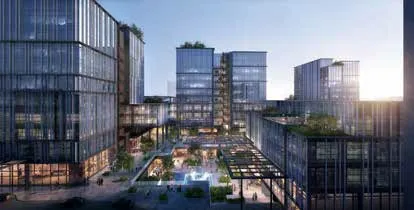
中国杭州镓谷科学园
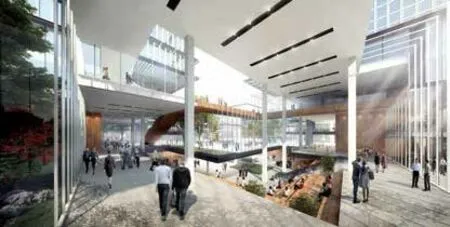
中国杭州镓谷科学园
In the longer term,these “self-functioning”smart buildings are critical for helping society transition to a net-zero-carbon future.Currently,buildings account for almost 40 percent of energyrelated global carbon emissions (WorldGBC 2020).The International Energy Agency (IEA) estimates that smart controls and connected devices in buildings could save 230 exajoules (EJ) in cumulative energy savings to 2040,which lowers building energy consumption by 10 percent globally,while enhancing thermal comfort and delivering greater amenities for building occupants (UNEP &IEA 2017).
To bring down global carbon emissions,architects around the world are working to develop “zeroenergy” buildings,which generate enough clean energy on-site for their own use,translating into net-zero energy consumption.Combined with government support,digital infrastructure and city planning initiatives,smart buildings are set to transform how we live,paving the way towards the building of smart cities.
Reimagining the Workspace
Not all jobs can be done remotely,and the office as a key workplace,especially for knowledge workers,is likely to persist for some time.At the same time,shifting global work patterns and rising concerns around well-being—trends that have been accelerated and intensified by the pandemic—are fostering new perspectives on what a desirable workplace looks like.
Flexibility is certainly a defining feature for such a desirable workplace.Employers recognize the provision of flexible working,both as a merit point for retaining and attracting high-caliber talent,and as an ingredient for boosting operational resilience at times when global mobility is restricted.This is why the future workspace must be characterized by spatial qualities and design features that allow people to work in the modes that best suit their style.
To engage users in their most productive and creative selves,well-being should be treated as a holistic,integrated concept with multiple dimensions.Designing the future workplace,therefore,also involves the collaboration of ever-more diverse disciplines,especially as the integration of BIM and IoT technologies becomes increasingly important for creating a comfortable,efficient environment for building users.
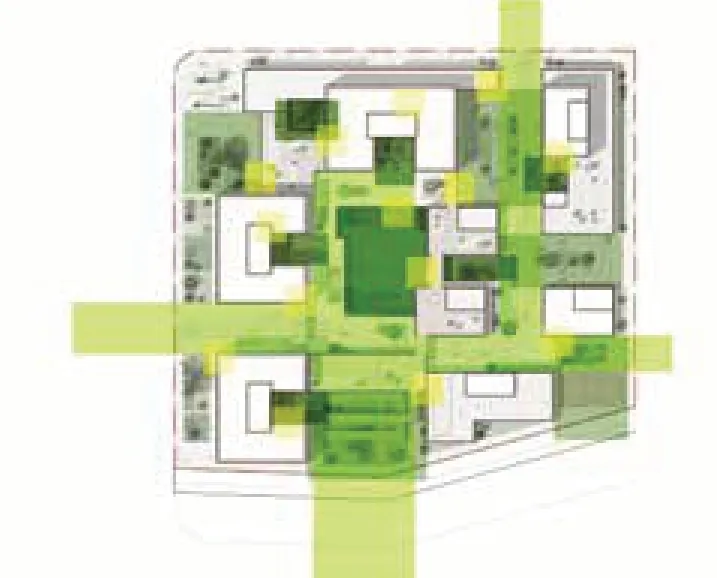
中国杭州镓谷科学园
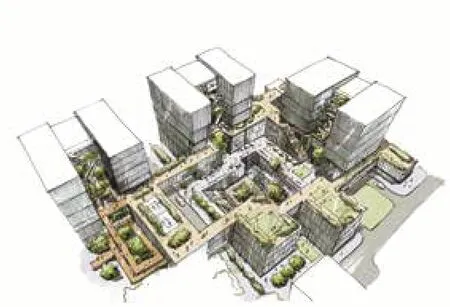
中国杭州镓谷科学园
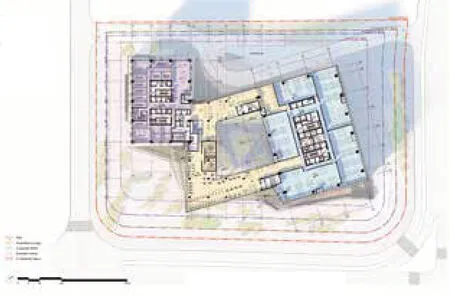
中国杭州奥体万科中心
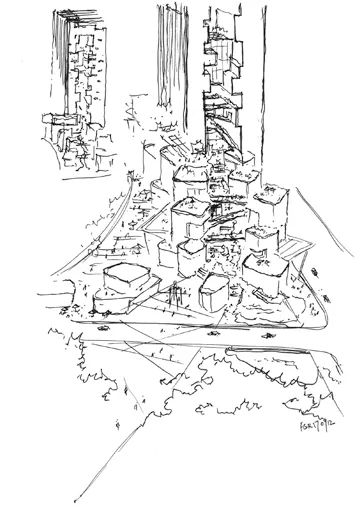
中国南京五星广场
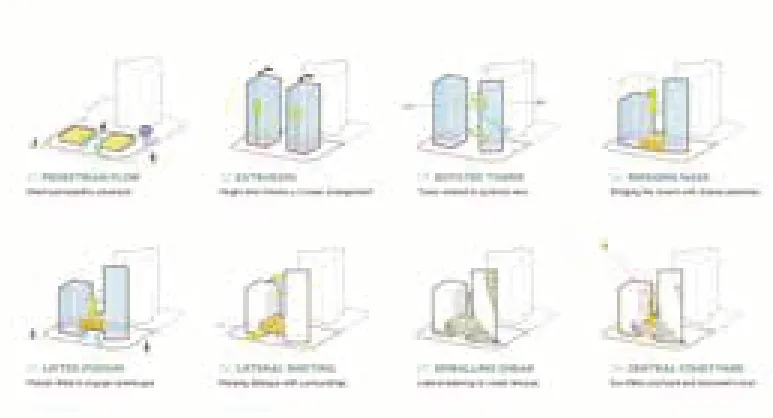
中国杭州奥体万科中心
Growing priorities for a work-life balance have also further dissolved the boundary between the workplace and “third places” for performing our daily life routines.To optimize the user experience,architects will be looking beyond the “functionality” of architecture to achieve spiritual wellness and positive social dynamics.
